Socio-Economic Assessment of Green Infrastructure for Climate Change Adaptation in the Context of Urban Drainage Planning
Abstract
1. Introduction
2. Materials and Methods
2.1. The Two Case Studies
2.1.1. The Case Study of Barcelona
2.1.2. The Case Study of Badalona
2.2. The Climate Change Adaptation Scenarios
2.2.1. Green Infrastructure in Barcelona
2.2.2. The Future Rainfalls in Barcelona
2.2.3. Green Infrastructure in Badalona
2.2.4. The Future Rainfalls in Badalona
2.3. The Cost-Benefit Analysis
2.3.1. Costs
2.3.2. Benefits
- Benefits derived from flood damage reduction. Benefits are defined as avoided direct and indirect flood damage costs. Flood damage costs were quantified in terms of Expected Annual Damage (EAD) using a 1D/2D urban drainage model together with design storms and a damage model based on tailored flood depth–damage curves [27]. The direct flood damages were quantified for infrastructure, vehicles, buildings and assets, while the indirect damages for business interruption.
- Benefits derived from water quality improvements. Benefits are defined as avoided direct and indirect damage costs. The direct damages are quantified as environmental costs produced by CSO spills to receiving water bodies and for avoided costs of combined sewage treatment. Indirect damages are monetized for coastal economies that are affected by the polluted water.
2.3.3. Net Benefits
3. Results
3.1. Costs
3.2. Benefits
3.3. Net benefits
4. Discussion
- (a)
- The hyetographs design storms (for all the considered return periods) were obtained from few rain gauges and uniformly applied to the whole catchment area in Barcelona. When calculating flood damages, it can be relevant to use design storms obtained by spatially averaged (over the catchment area) Intensity Duration Frequency (IDF) curves or multiply the rainfall intensity by a reduction coefficient that is a function of the catchment area: the larger the area, the lower the coefficient. In the case of Badalona, the project storm hyetographs presented blocks with maximum rainfall intensity corresponding to different return periods in order to take into account the correspondence of the project storms intensities with the observed rainfall data for extreme events [46].
- (b)
- The discretization used in the flood damage vs exceedance probability curve and the integration method used to compute EAD (the integral of the flood damage curve over the exceedance probability domain) introduced a significant numerical error with consequent overestimation, particularly for the case of Barcelona. Figure 3 showed the flood damage vs exceedance probability for the case of Barcelona together with the linear interpolation lines that were used for the calculation of the area below the curve that corresponds to the EAD. The figure shows that the selected simulated points might not be enough to properly describe the non-linear relation between flood damages and exceedance probability, particularly for the case of Barcelona (Figure 3a) for the range of exceedance probability between 0.1 (10 year return period) and 1 (1 year return period). By introducing new simulation points (for instance at 0.2 exceedance probability) the EAD (the area below the curve) might significantly reduce [4,47].
5. Conclusions
Author Contributions
Funding
Acknowledgments
Conflicts of Interest
References
- Fletcher, T.D.; Shuster, W.; Hunt, W.F.; Ashley, R.; Butler, D.; Arthur, S.; Trowsdale, S.; Barraud, S.; Semadeni-Davies, A.; Bertrand-Krajewski, J.-L.; et al. SUDS, LID, BMPs, WSUD and more—The evolution and application of terminology surrounding urban drainage. Urban Water J. 2014, 9006, 1–18. [Google Scholar] [CrossRef]
- Yu, H.Z. Complicated structure modeling in front-zone of Hala’alate Mountain of northwestern margin, Junggar Basin. Nat. Gas Geosci. 2014, 25, 91–97. [Google Scholar]
- Zhou, Q.; Halsnæs, K.; Arnbjerg-Nielsen, K. Economic assessment of climate adaptation options for urban drainage design in Odense, Denmark. Water Sci. Technol. 2012, 66, 1812–1820. [Google Scholar] [CrossRef]
- Velasco, M.; Russo, B.; Cabello Termes, M.; Sunyer, D.; Malgrat, P. Assessment of the effectiveness of structural and nonstructural measures to cope with global change impacts in Barcelona. J. Flood Risk Manag. 2018, 11, S55–S68. [Google Scholar] [CrossRef]
- Zhou, Q.; Mikkelsen, P.S.; Halsnæs, K.; Arnbjerg-Nielsen, K. Framework for economic pluvial flood risk assessment considering climate change effects and adaptation benefits. J. Hydrol. 2012, 414–415, 539–549. [Google Scholar] [CrossRef]
- Alves, A.; Gersonius, B.; Kapelan, Z.; Vojinovic, Z.; Sanchez, A. Assessing the Co-Benefits of green-blue-grey infrastructure for sustainable urban flood risk management. J. Environ. Manag. 2019, 239, 244–254. [Google Scholar] [CrossRef] [PubMed]
- Löwe, R.; Urich, C.; Sto. Domingo, N.; Mark, O.; Deletic, A.; Arnbjerg-Nielsen, K. Assessment of urban pluvial flood risk and efficiency of adaptation options through simulations—A new generation of urban planning tools. J. Hydrol. 2017, 550, 355–367. [Google Scholar]
- Zhou, Q.; Panduro, T.E.; Thorsen, B.J.; Arnbjerg-Nielsen, K. Adaption to extreme rainfall with open urban drainage system: An integrated hydrological cost-benefit analysis. Environ. Manag. 2013, 51, 586–601. [Google Scholar] [CrossRef]
- Cooper, W.; Garcia, F.; Pape, D.; Ryder, D.; Witherell, B. Climate Change Adaptation Case Study: Benefit-Cost Analysis of Coastal Flooding Hazard Mitigation. J. Ocean Coast. Econ. 2016, 3. [Google Scholar] [CrossRef]
- Venkataramanan, V.; Lopez, D.; McCuskey, D.J.; Kiefus, D.; McDonald, R.I.; Miller, W.M.; Packman, A.I.; Young, S.L. Knowledge, attitudes, intentions, and behavior related to green infrastructure for flood management: A systematic literature review. Sci. Total Environ. 2020, 720, 137606. [Google Scholar] [CrossRef]
- Wilkerson, M.L.; Mitchell, M.G.E.; Shanahan, D.; Wilson, K.A.; Ives, C.D.; Lovelock, C.E.; Rhodes, J.R. The role of socio-economic factors in planning and managing urban ecosystem services. Ecosyst. Serv. 2018, 31, 102–110. [Google Scholar] [CrossRef]
- Arnbjerg-Nielsen, K. Quantification of climate change effects on extreme precipitation used for high resolution hydrologic design. Urban Water J. 2012, 9, 57–65. [Google Scholar] [CrossRef]
- Rodr, R.; Navarro, X.; Casas, M.C.; Ribalaygua, J.; Russo, B.; Pouget, L.; Reda, A. Influence of climate change on IDF curves for the metropolitan area of Barcelona (Spain). Int. J. Climatol. 2014, 654, 643–654. [Google Scholar]
- Löwe, R.; Urich, C.; Kulahci, M.; Radhakrishnan, M.; Deletic, A.; Arnbjerg-Nielsen, K. Simulating flood risk under non-stationary climate and urban development conditions—Experimental setup for multiple hazards and a variety of scenarios. Env. Model. Softw. 2018, 102, 155–171. [Google Scholar] [CrossRef]
- Àrea de Medi Ambient. Pla Tècnic per L’aprofitament dels Recursos Hídrics Alternatius a Barcelona: Vol I/III Doc. Núm. 1: Memòria i Annexos; Repositori Obert de Coneixement de l’Ajuntament de Barcelona: Barcelona, Spain, 2009. [Google Scholar]
- BCN. Ecologia. Cobertes i Murs Verds a Barcelona: Estudi sobre les existents, el potencial i les estretègies d’implantació. 2010. Available online: http://bcnecologia.net/sites/default/files/proyectos/doc_cobertes_i_murs_verds_01m2010_0.pdf (accessed on 1 April 2020).
- Locatelli, L.; Gabriel, S.; Mark, O.; Mikkelsen, P.S.; Arnbjerg-Nielsen, K.; Taylor, H.; Bockhorn, B.; Larsen, H.; Kjølby, M.J.; Blicher, A.S.; et al. Modelling the impact of retention-detention units on sewer surcharge and peak and annual runoff reduction. Water Sci. Technol. 2015, 71, 898–903. [Google Scholar] [CrossRef] [PubMed]
- Monjo, R.; Gaitán, E.; Pórtoles, J.; Ribalaygua, J.; Torres, L. Changes in extreme precipitation over Spain using statistical downscaling of CMIP5 projections. Int. J. Clim. 2016, 36, 757–769. [Google Scholar] [CrossRef]
- Rust, H.W.; Richling, A.; Meredith, E.; Fischer, M.; Vagenas, C.; Kadow, C.; Ulbrich, U. Climate Predictions and Downscaling to Extreme Weather. 2018. Available online: http://www.projectbingo.eu/output/climate-predictions (accessed on 1 April 2020).
- Rodriguez-Iturbe, I.; Cox, D.R.; Isham, V. Some models for rainfall based on stochastic point processes. Proc. R. Soc. Lond. A Math. Phys. Sci. 1987, 410, 269–288. [Google Scholar]
- Narayanan, A.; Pitt, R. Costs of Urban Stormwater Control Practices; Department of Civil, Construction, and Environmental Engineering, The University of Alabama: Tuscaloosa, AL, USA, 2006. [Google Scholar]
- Bianchini, F.; Hewage, K. Probabilistic social cost-benefit analysis for green roofs: A lifecycle approach. Build. Environ. 2012, 58, 152–162. [Google Scholar] [CrossRef]
- Zhou, Q.; Arnbjerg-Nielsen, K. Uncertainty assessment of climate change adaptation options using an economic pluvial flood risk framework. Water 2018, 10, 1877. [Google Scholar] [CrossRef]
- Feng, H.; Hewage, K.N. Economic Benefits and Costs of Green Roofs. In Nature Based Strategies for Urban and Building Sustainability; Elsevier Inc.: Amsterdam, The Netherlands, 2018; pp. 307–318. ISBN 9780128123249. [Google Scholar]
- Sartori, D.; Catalano, G.; Genco, M.; Pancotti, C.; Sirtori, E.; Vignetti, S.; Del Bo, C. Guide to Cost-benefit Analysis of Investment Projects: Economic appraisal tool for Cohesion Policy 2014–2020. Eur. Commision 2014, 349. [Google Scholar] [CrossRef]
- Smith, K.; Ward, R. Floods: Physical Processes and Human Impacts; Wiley: Hoboken, NJ, USA, 1998; ISBN 978-0-471-95248-0. [Google Scholar]
- Martínez-Gomariz, E.; Locatelli, L.; Guerrero, M.; Russo, B.; Martínez, M. Socio-Economic Potential Impacts Due to Urban Pluvial Floods in Badalona (Spain) in a Context of Climate Change. Water 2019, 11, 2658. [Google Scholar] [CrossRef]
- Martínez-Gomariz, E.; Gómez, M.; Russo, B.; Sánchez, P.; Montes, J.A. Methodology for the damage assessment of vehicles exposed to flooding in urban areas. J. Flood Risk Manag. 2018, 1–15. [Google Scholar] [CrossRef]
- Hallegatte, S. An adaptive regional input-output model and its application to the assessment of the economic cost of Katrina. Risk Anal. 2008, 28, 779–799. [Google Scholar] [CrossRef] [PubMed]
- Lorenzo, C.; Standardi, G.; Bosello, F.; Mysiak, J. Assessing Direct and Indirect Economic Impacts of a Flood Event through the Integration of Spatial and Computable General Equilibrium Modelling; Research Papers Issue RP0202 December 2013; Centro Euro-Mediterraneo sui Cambiamenti Climatici: Lecce, Italy, 2013. [Google Scholar]
- Locatelli, L.; Russo, B.; Martinez, M. Evaluating health hazard of bathing waters affected by combined sewer overflows. Nat. Hazards Earth Syst. Sci. Discuss. 2019, 1–19. [Google Scholar] [CrossRef]
- Barcelona, D. Pla estratègic dels espais litorals de la ciutat. Available online: https://www.decidim.barcelona/processes/PlaLitoralBCN (accessed on 1 April 2020).
- Turrión-Prats, J.; Duro, J.A. Tourist seasonality in Catalonia. Tour. Econ. 2017, 23, 846–853. [Google Scholar] [CrossRef]
- De Bruin, K.; Dellink, R.; Agrawala, S.; Dellink, R. Economic Aspects of Adaptation to Climate Change: Integrated Assessment Modelling of Adaptation Costs and Benefits. Oecd Environ. Work. Pap. 2009, 22, 36–38. [Google Scholar]
- Decreto 459/2013. de 10 de Diciembre, Sobre los Vertidos Efectuados Desde Tierra al Mar. Boletín Oficial del País Vasco; Departamento de Medio Ambiente y Politica Territorial: Bilbao, Spain, 2014. [Google Scholar]
- Holt, A. Ex Post Evaluation of Cohesion Policy Interventions 2000-2006 Financed by the Cohesion Fund. WP C Cost Benefit Analysis of Environment Projects; Publications Office of Eurepean Union: Luxembourg, 2011. [Google Scholar]
- Chiabai, A.; Galarraga, I. Determining Discount Rates: An Application of the Equivalency Principle; EU: Brussels, Belgium, 2016. [Google Scholar]
- Griffin, R.C. Water Resource Economics: The Analysis of Scarcity, Policies, and Projects; MIT Press: Cambridge, MA, USA, 2006; ISBN 9780262072670. [Google Scholar]
- Aaheim, A. The determination of optimal climate policy. Ecol. Econ. 2010, 69, 562–568. [Google Scholar] [CrossRef]
- Stern, N. The Economics of Climate Change: The Stern Review; Cambridge University Press: Cambridge, UK, 2007; ISBN 9780511817434. [Google Scholar]
- Pearce, D.; Atkinson, G.; Mourato, S. Cost-Benefit Analysis and the Environment: Recent Developments; Organisation for Economic Cooperation and Development (OECD): Paris, France, 2006; ISBN 9789264010055. [Google Scholar]
- Oxera a Social Time Preference for Use in Long-Term Discounting. Available online: https://www.oxera.com/publications/a-social-time-preference-for-use-in-long-term-discounting/ (accessed on 3 March 2020).
- Locatelli, L.; Mark, O.; Mikkelsen, P.S.; Arnbjerg-Nielsen, K.; Wong, T.; Binning, P.J. Determining the extent of groundwater interference on the performance of infiltration trenches. J. Hydrol. 2015, 529, 1360–1372. [Google Scholar] [CrossRef]
- Locatelli, L.; Mark, O.; Mikkelsen, P.S.; Arnbjerg-Nielsen, K.; Bergen Jensen, M.; Binning, P.J. Modelling of green roof hydrological performance for urban drainage applications. J. Hydrol. 2014, 519, 3237–3248. [Google Scholar] [CrossRef]
- Bockhorn, B.; Klint, K.E.S.; Locatelli, L.; Park, Y.-J.; Binning, P.J.; Sudicky, E.; Bergen Jensen, M. Factors affecting the hydraulic performance of infiltration based SUDS in clay. Urban Water J. 2017, 14, 125–133. [Google Scholar] [CrossRef][Green Version]
- Raso, J.; Malgrat, P.; Castillo, F. Improvement in the selection of design storms for the New Master Drainage Plan of Barcelona. Water Sci. Technol. 1995, 32, 217–224. [Google Scholar] [CrossRef]
- Olsen, A.S.; Zhou, Q.; Linde, J.J.; Arnbjerg-Nielsen, K. Comparing methods of calculating expected annual damage in urban pluvial flood risk assessments. Water 2015, 7, 255–270. [Google Scholar] [CrossRef]
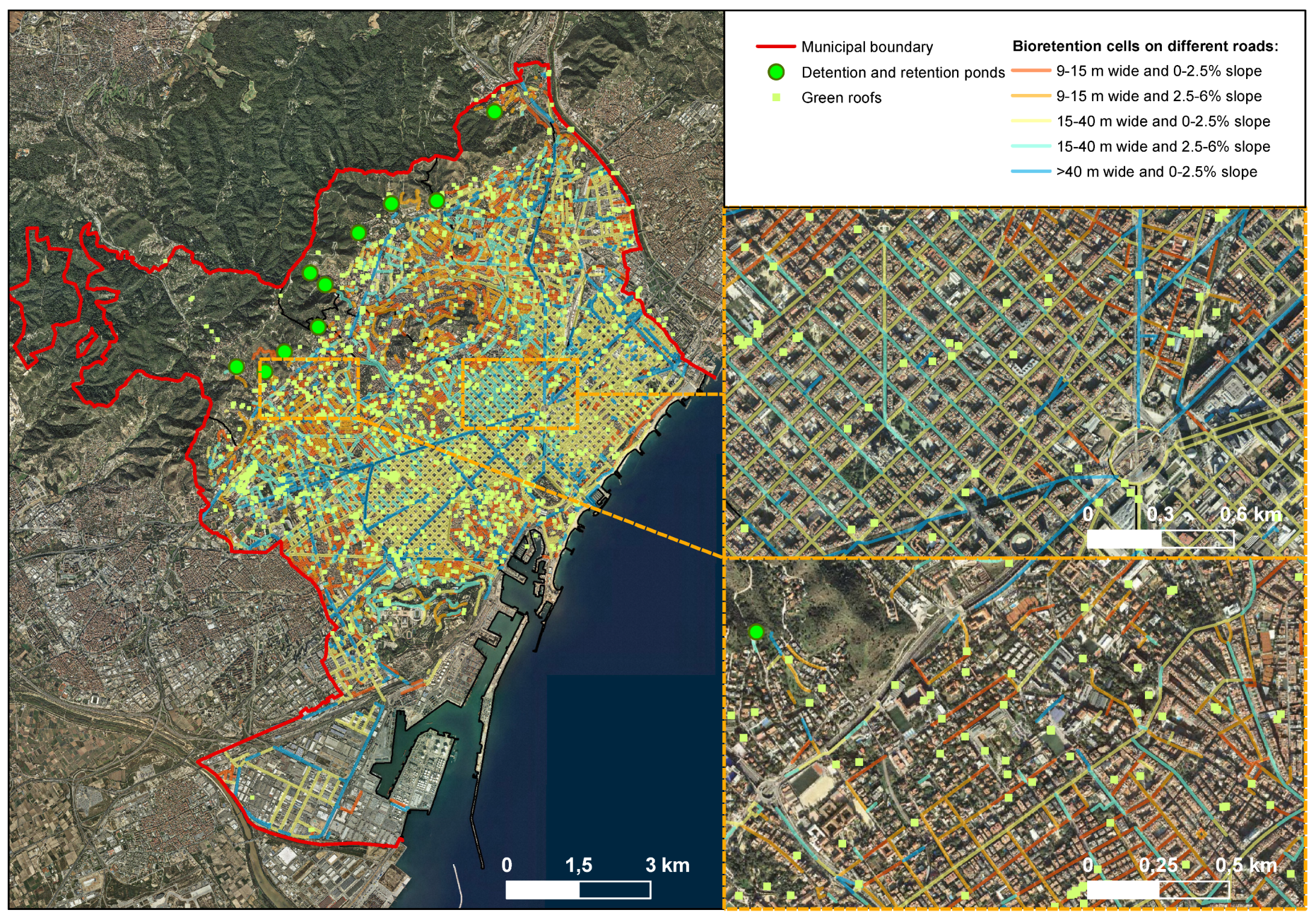


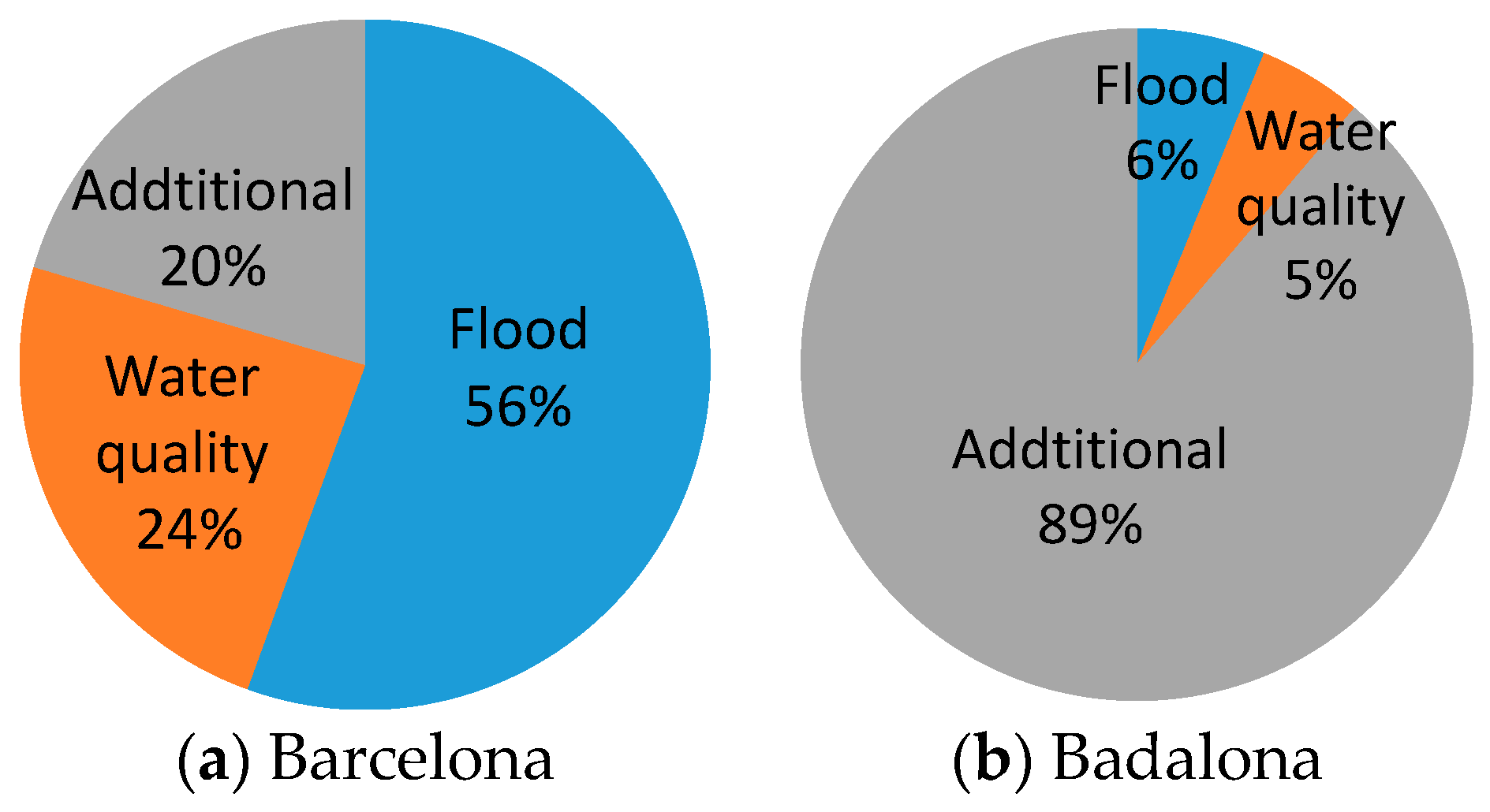
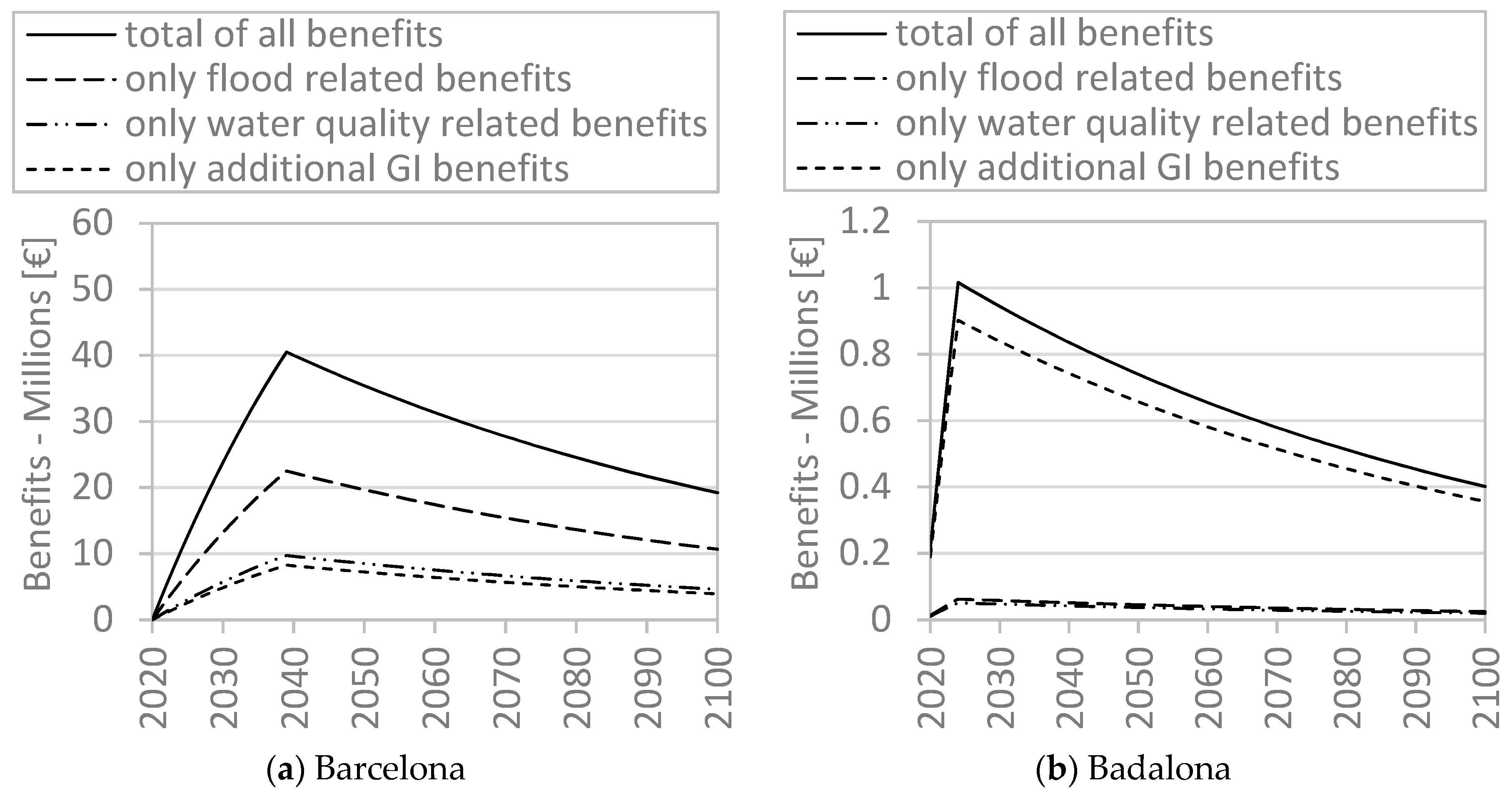
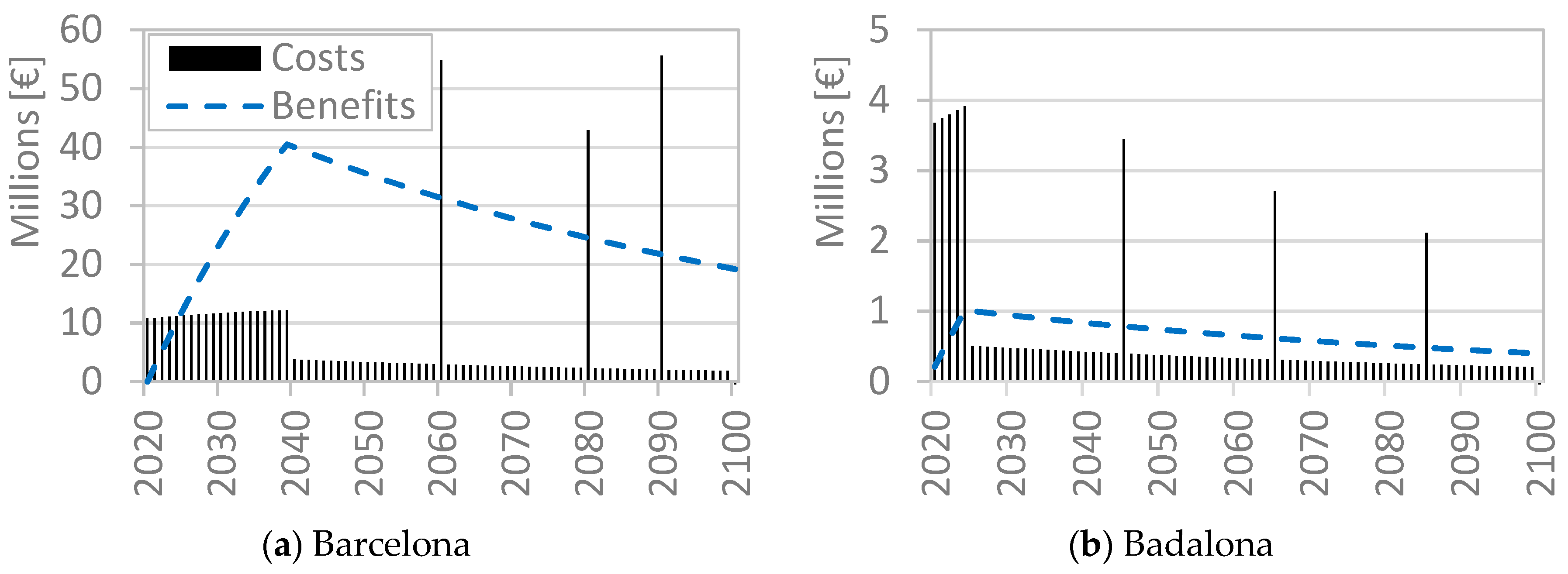
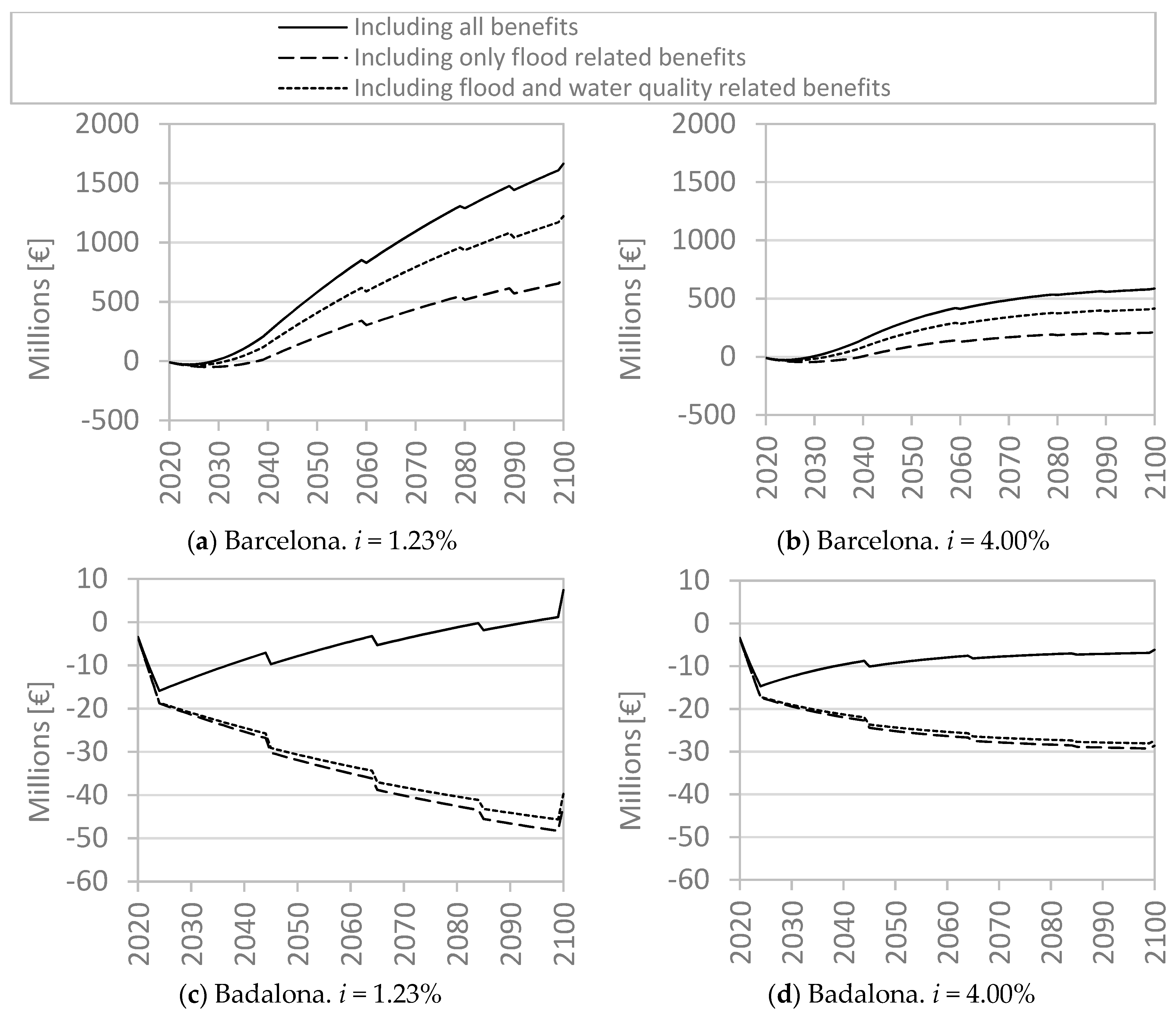
| Badalona | Barcelona | |||
|---|---|---|---|---|
| CAPEX [€] | OPEX [€/y] | CAPEX [€] | OPEX [€/y] | |
| Green roofs | 14,534,788 | 405,157 | 114,752,240 | 3,342,159 |
| Infiltration trenches | 1,783,561 | 96,150 | ||
| Permeable pavements | 1,739,183 | 48,311 | ||
| Bioretention cells | 85,509,743 | 1,357,298 | ||
| Detention and retention ponds | 12,870,000 | 191,763 | ||
| TOTAL | 18,057,531 | 549,618 | 213,131,983 | 4,891,220 |
| M€/y | ||
|---|---|---|
| Barcelona | EAD. BAU | 62.65 |
| EAD. GI | 33.90 | |
| Flood damage reduction | 28.75 | |
| Badalona | EAD. BAU | 1.93 |
| EAD. GI | 1.86 | |
| Flood damage reduction | 0.07 | |
| Barcelona | Badalona | ||||||
|---|---|---|---|---|---|---|---|
| Benefit Category | Description | Value [€] | Percentage | Aggregated Percentages | Value [€] | Percentage | Aggregated Percentages |
| Benefits derived from flood damage reduction | Avoided direct and indirect flood damage costs | 28,745,795 | 56% | 56% | 66,536 | 6% | 6% |
| Benefits derived from water quality improvements | Avoided environmental damage due to CSO to receiving waters | 11,876,496 | 23% | 24% | 44,306 | 4% | 5% |
| Avoided cost of combined waste water treatment | 274,985 | 1% | 945 | 0% | |||
| Avoided indirect damages to coastal economies | 270,474 | 1% | 9043 | 1% | |||
| Additional benefits | Added aesthetic value | 6,393,959 | 12% | 20% | 436,044 | 40% | 89% |
| Air quality improvement | 71,272 | 0% | 3992 | 0% | |||
| Habitat provision | 4,016,328 | 8% | 508,718 | 47% | |||
| Reduction of urban heat island effect and energy consumption | 85,031 | 0% | 10,770 | 1% | |||
| TOTAL | 51,734,342 | 1,080,354 | |||||
© 2020 by the authors. Licensee MDPI, Basel, Switzerland. This article is an open access article distributed under the terms and conditions of the Creative Commons Attribution (CC BY) license (http://creativecommons.org/licenses/by/4.0/).
Share and Cite
Locatelli, L.; Guerrero, M.; Russo, B.; Martínez-Gomariz, E.; Sunyer, D.; Martínez, M. Socio-Economic Assessment of Green Infrastructure for Climate Change Adaptation in the Context of Urban Drainage Planning. Sustainability 2020, 12, 3792. https://doi.org/10.3390/su12093792
Locatelli L, Guerrero M, Russo B, Martínez-Gomariz E, Sunyer D, Martínez M. Socio-Economic Assessment of Green Infrastructure for Climate Change Adaptation in the Context of Urban Drainage Planning. Sustainability. 2020; 12(9):3792. https://doi.org/10.3390/su12093792
Chicago/Turabian StyleLocatelli, Luca, Maria Guerrero, Beniamino Russo, Eduardo Martínez-Gomariz, David Sunyer, and Montse Martínez. 2020. "Socio-Economic Assessment of Green Infrastructure for Climate Change Adaptation in the Context of Urban Drainage Planning" Sustainability 12, no. 9: 3792. https://doi.org/10.3390/su12093792
APA StyleLocatelli, L., Guerrero, M., Russo, B., Martínez-Gomariz, E., Sunyer, D., & Martínez, M. (2020). Socio-Economic Assessment of Green Infrastructure for Climate Change Adaptation in the Context of Urban Drainage Planning. Sustainability, 12(9), 3792. https://doi.org/10.3390/su12093792






